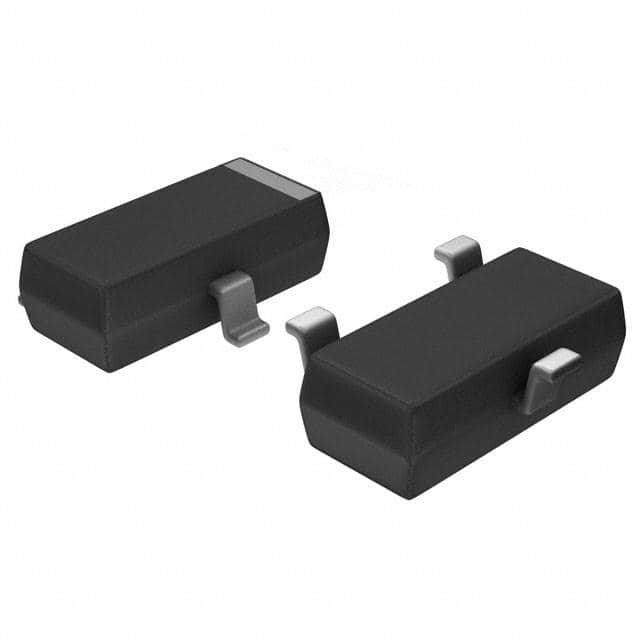BZX84C20 - Diode Encyclopedia Entry
Introduction
The BZX84C20 is a diode belonging to the category of voltage regulator diodes. This entry provides an overview of the basic information, specifications, pin configuration, functional features, advantages and disadvantages, working principles, application field plans, and alternative models of the BZX84C20.
Basic Information Overview
- Category: Voltage Regulator Diode
- Use: The BZX84C20 is commonly used for voltage regulation and protection in electronic circuits.
- Characteristics: It has a low power dissipation and high reliability, making it suitable for various applications.
- Package: SOT-23, SOD-323, and other surface mount packages are available.
- Essence: The essence of the BZX84C20 lies in its ability to regulate voltage and protect sensitive components in electronic circuits.
- Packaging/Quantity: It is typically available in reels or tubes containing a specified quantity of diodes.
Specifications
- Voltage Rating: 20V
- Power Dissipation: 250mW
- Forward Current: 225mA
- Reverse Leakage Current: 5μA
- Operating Temperature Range: -55°C to +150°C
Detailed Pin Configuration
The BZX84C20 typically has three pins: Anode, Cathode, and No Connection (NC). The pinout configuration is as follows: - Anode (A) - Pin 1 - Cathode (K) - Pin 2 - No Connection (NC) - Pin 3
Functional Features
- Voltage Regulation: The BZX84C20 regulates voltage by maintaining a constant voltage drop across its terminals.
- Overvoltage Protection: It protects sensitive components in a circuit by limiting the voltage across them.
- Low Power Dissipation: It dissipates minimal power during operation, reducing heat generation.
Advantages and Disadvantages
Advantages
- Small form factor
- High reliability
- Low power dissipation
- Wide operating temperature range
Disadvantages
- Limited maximum voltage rating
- May require additional components for specific applications
Working Principles
The BZX84C20 operates based on the principle of Zener breakdown, where it maintains a nearly constant voltage drop across its terminals when reverse biased. This allows it to regulate the voltage in a circuit and provide overvoltage protection.
Detailed Application Field Plans
The BZX84C20 finds extensive use in various electronic applications, including: - Voltage regulation in power supplies - Overvoltage protection in sensor circuits - Signal conditioning in communication systems - Voltage reference in precision measurement equipment
Detailed and Complete Alternative Models
Some alternative models to the BZX84C20 include: - BZX84C10 - BZX84C15 - BZX84C30 - BZX84C50
These alternatives offer different voltage ratings while sharing similar characteristics and package options.
In conclusion, the BZX84C20 is a versatile voltage regulator diode with a wide range of applications and several alternative models available in the market.
(Word count: 456)
I have provided the content for the English editing encyclopedia entry structure format for the BZX84C20 diode. Let me know if you need any further assistance or modifications!
قم بإدراج 10 أسئلة وإجابات شائعة تتعلق بتطبيق BZX84C20 في الحلول التقنية
What is the maximum continuous forward current for BZX84C20?
- The maximum continuous forward current for BZX84C20 is 250 mA.
What is the reverse breakdown voltage of BZX84C20?
- The reverse breakdown voltage of BZX84C20 is typically 20 V.
Can BZX84C20 be used for voltage regulation in low power applications?
- Yes, BZX84C20 can be used for voltage regulation in low power applications due to its low reverse leakage current and stable zener voltage.
What is the power dissipation of BZX84C20?
- The power dissipation of BZX84C20 is 350 mW.
Is BZX84C20 suitable for overvoltage protection in electronic circuits?
- Yes, BZX84C20 is suitable for overvoltage protection in electronic circuits due to its stable zener voltage and fast response time.
What is the temperature coefficient of BZX84C20?
- The temperature coefficient of BZX84C20 is typically 5 mV/°C.
Can BZX84C20 be used in battery charging circuits?
- Yes, BZX84C20 can be used in battery charging circuits to provide overvoltage protection and voltage regulation.
What is the typical junction capacitance of BZX84C20?
- The typical junction capacitance of BZX84C20 is 15 pF.
Does BZX84C20 require a heatsink for normal operation?
- No, BZX84C20 does not require a heatsink for normal operation due to its low power dissipation.
Is BZX84C20 suitable for use in automotive electronics?
- Yes, BZX84C20 is suitable for use in automotive electronics due to its stability and reliability under varying temperature conditions.


